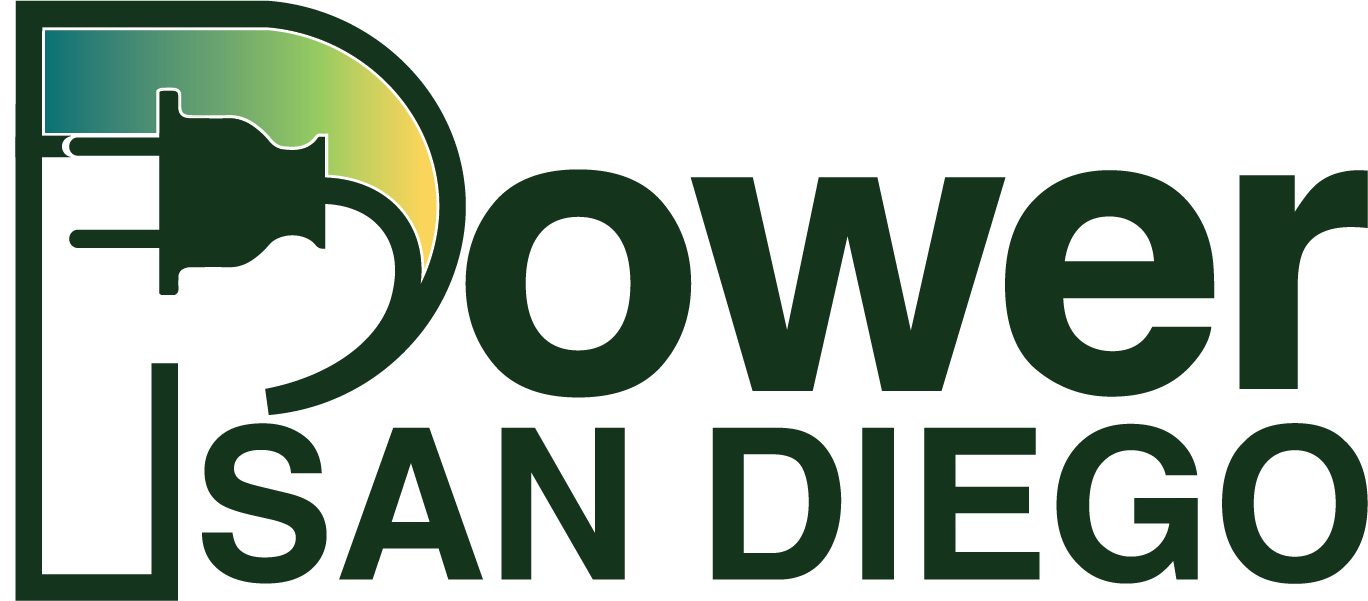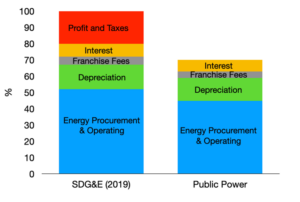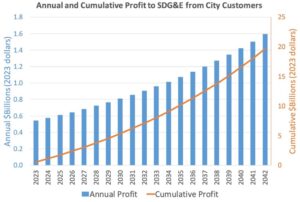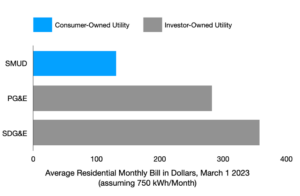“I believe in the municipal ownership of these monopolies because if you do not own them they in turn will own you. They will rule your politics, corrupt your institutions and finally destroy your liberties.” Tom Johnson, Mayor Cleveland, 1901-1909

Common Questions
Top Questions
Is this for all of SDGE's territory?
Currently, our initiative is focused solely on the city of San Diego.
Due to constraints in resources and financial backing, expanding our initiative to encompass the entire county remains beyond our current scope. Implementing measures at a county level typically necessitates significant funding, primarily for signature collection campaigns. In contrast, our project thrives on the enthusiasm and voluntary contributions of individuals like you.
Our aspiration was indeed to initiate this measure on a county-wide scale, considering the broader impact. However, we also understand the urgency of initiating immediate action. By starting in San Diego city, we aim to create a model of success that can eventually be replicated across the county.
Who will pay for the not-for-profit utility Power San Diego will create?
The not-for-profit utility will take out a municipal revenue bond to pay SDGE for the assessed value of about $2.3 Billion. The bond will be paid back by us, the rate-payers, at a cost of about 2¢ Kw/H over 30 years. This is a small fraction of the 48 c Kw/H we are already paying.
We are currently paying SDGE for these assets. The purchase would be equivalent to a homeowner refinancing a home loan at a lower interest rate.
How much will we save?
In the range of 20% in the short-term by no longer paying the SDGE profit and associated taxes, and much more later. We would save $20 billion by 2042 on the avoided profits to SDGE alone, assuming the historic rate of SDGE profit growth over the last decade.
Does the community have the right to take over electric service, if it chooses to do so?
Yes. See Sections 1 and 104 of the San Diego City Charter:
Section 1: “The municipal corporation now existing and known as “The City of San Diego” … may own and acquire property within or without its boundaries for either governmental or proprietary, or any municipal purpose, either by succession, annexation, purchase, devise, lease, gift or condemnation. “
Section 104: “The Council may fix the term of each new franchise in accordance with the laws of the State of California, provided that any franchise may be terminated by ordinance whenever the City shall determine to acquire by condemnation or otherwise the property of any utility necessary for the welfare of the City, such termination to be effective upon and not before payment of the purchase price for the property to be acquired.
SDGE has acknowledged that the City can exercise this right at any time.[3] SDGE will be fairly compensated for the electric assets, ideally by mutually agreeing with the City on a purchase price. If SDGE refuses to sell, or insists on an unduly inflated price, the City may consider condemnation action under its right of eminent domain. If the electric distribution system is acquired through condemnation, the courts or state statutes will determine the just compensation amount.
Why would SDGE allow this to happen?
Under the San Diego City charter the people have the right to do this, and that right is recognized by SDG&E. See Sections 1 and 104 of the San Diego City Charter.
Section 1: “The municipal corporation now existing and known as “The City of San Diego” … may own and acquire property within or without its boundaries for either governmental or proprietary, or any municipal purpose, either by succession, annexation, purchase, devise, lease, gift or condemnation. “
Section 104: “The Council may fix the term of each new franchise in accordance with the laws of the State of California, provided that any franchise may be terminated by ordinance whenever the City shall determine to acquire by condemnation or otherwise the property of any utility necessary for the welfare of the City, such termination to be effective upon and not before payment of the purchase price for the property to be acquired.
SDG&E has acknowledged that the City can exercise this right at any time. SDG&E will be fairly compensated for the electric and natural gas assets, ideally by mutually agreeing with the City on a purchase price. If SDG&E refuses to sell, or insists on an unduly inflated price, the City may consider condemnation action under its right of eminent domain. If the electric and natural gas systems are acquired through condemnation, the courts or state statutes will determine the just compensation amount.
How will this help rooftop solar owners?
It will help current and future rooftop solar owners enormously. Current rooftop owners are now facing large monthly SDGE fixed charges selectively targeting rooftop solar customers that will be implemented in 2024. The fixed charges that customers not on discounted rates (about 75% of residential customers) will soon pay, even if they generate all their electricity from solar, range from $756 per year to $1,416 per year. What is more, SDGE rates are growing at about 10% per year. The not-for-profit utility would not impose fixed charges.
I will sign the initiative!
Sign me up to help!
FAQ Sections
Cost
Savings
Differences
Union Workers
Cost
How would the costs to purchase SDGE’s assets in the City of San Diego be financed?
A municipal revenue bond. The strategy was spelled out in the JVJ consulting report commissioned by the City in 2020, and again by NewGen Strategies in its July 2023 public power report to the City.
What will it cost?
The value of the distribution grid poles and wires has been assessed, in a July 2023 public power report financed by the city, at about $1.7 billion. This sum represents the “Original Cost Less Depreciation – OCLD” market value of the poles and wires.
The cost of “separation and reintegration” of the City’s distribution grid, to reconfigure substations that serve both San Diego residents and neighboring communities, is estimated in the July 2023 report at about $250 million. Finally, the report estimates startup costs at $300 million. The total cost would be about $2.3 billion.
Would the cost burden San Diego Residents?
Absolutely not.
This would be equivalent to a homeowner refinancing a home loan at a lower interest rate. San Diego residents already pay a “mortgage” to SDGE on the market value of the poles and wires. The non-profit electric utility would finance this capital expense due to SDGE with a lower municipal revenue bond. The bond would be paid back by San Diegans over a 30-year period.
Is the cost of purchasing SDGE’s electric assets in the City of San Diego an impediment to forming a municipal utility?
No.
The amortized cost to purchase SDGE electric distribution assets at current market value in the City of San Diego, including severance and startup costs, would be less than $0.02/kWh.[1] That would be $10/month on the average residential customer’s monthly bill.[2] This capital expense would be recovered from a high volume of electric power sales to City customers, more than 8 billion kilowatt-hours per year, over 30 years.
For comparison, the SDG&E all-in non-discounted retail residential electric rate is $0.48/kWh in 2023
[1] NewGen Strategies. Total electric acquisition costs = $2,300,000,000 (capital assets, severance, capital start-up); municipal bond, 30 years, 4% interest (capital recovery factor = 0.0578), 8 billion kWh/year sales. Unit total acquisition revenue requirement = ($2.3 billion x 0.0578)/8 billion kWh/yr = $0.017/kWh.
[2] Average residential consumption is 600 kWh/month. 600 kWh/month x $0.017/kWh = $10/month.
Who paid for SDGE’s electric and natural gas assets?
The City of San Diego ratepayers and all the other customers of SDG&E. Although its customers pay to build, operate, and maintain all of SDG&E’s equipment and facilities – and pay for a profit on all the assets – SDG&E retains legal ownership of the assets.
Would the repayment of this revenue bond have a substantial impact on rates?
No.
At an asset value of $2.3 billion (including severance costs and startup costs), the impact on electric rates would be less than $0.02 per kilowatt-hour (kWh). In contrast, the average electric rate for most San Diego residential customers in 2023 is nearly $0.50/kWh. The asset purchase price is spread over 30 years, over more than 8 billion kilowatt-hours per year of sales, at low municipal bond rates. That is why the asset purchase cost does not move the needle much on customer rates. We are currently paying SDG&E for these assets. The purchase would be equivalent to a homeowner refinancing a home loan at a lower interest rate. That is all.
Do SDGE customers also pay for all taxes owed by SDGE?
Yes.
In contrast, a not-for-profit public utility has no tax obligations.
What did the City’s consultant JVJ conclude about the effect of the purchase price on the cost City residents would pay for electric service?
JVJ indicated in its 2020 report that the annual debt service for the purchase of SDGE electric distribution assets by the City would be a small portion of the total cost of electric service, stating: “The purchase price assumption does not have significant effect on the cost customers would pay for electric distribution utility service.” (pg.54)
Savings
How much would a not-for-profit utility save overall?
As explained above, a not-for-profit utility would initially save about 20 to 25%, primarily by eliminating profits and taxes that would otherwise be collected by SDGE.
The effect of eliminating these profit and tax collections is shown in the figure below. The switch to a not-for-profit electric utility would also eliminate SDGE expenditures on excessive senior executive salaries ($17 million per year to the CEO in 2022), advertising, contributions to candidates and elected officials, lobbying organizations, and influential local non-profit organizations.
 A non-profit utility would lead to short term savings of at least 20%, and long-term savings of more.
A non-profit utility would lead to short term savings of at least 20%, and long-term savings of more.
Is a major reason for the lower customer costs for not-for-profit utilities is that they do not collect shareholder profits, unlike private monopoly utilities like SDGE?
Yes. SDGE currently makes over $1.4 million a day in profit from its City of San Diego customers. A San Diego not-for-profit electric utility would collect no profit from San Diego customers.
How will the not-for-profit electric utility reduce rates, beyond eliminating the need to generate profits for shareholders?
The mission of the not-for-profit electric utility will be to reduce electric rates by maximizing local solar and battery development.
This local power would not be subject to the high, onerous, and rising transmission access charges imposed by SDGE on all delivered retail power, making local solar and storage the lowest-cost power option for City residents.
The proposed not-for-profit utility will commence operations in January 2027. The production cost of rooftop solar will be one-half of SDGE’s transmission charge in 2027, according to National Renewable Energy Laboratory production cost forecasts. Local power produced by the not-for-profit electric utility and its customers would not be subject to the exit fee (PCIA – Power Charge Indifference Adjustment) imposed on community choice energy customers, further reducing the cost of power supply to City residents.
How much money will we save by not paying profit over a 20 year period?
The California Public Utilities Commission (CPUC) projects that rates will increase for SDG&E customers at about 10.4% per year.* Assuming that rate of increase, and assuming the current daily profit of $1.4 million the figure below shows how that profit will rise to about $20 billion by 2042.

* CPUC, 2023 SENATE BILL 695 REPORT (May 2023) Report to the Governor and Legislature on Actions to Limit Utility Cost and Rate Increases Pursuant to Public Utilities Code Section 913.1. p.10. “. . . average annual rate increases between the first quarter of 2023 and fourth quarter of 2026 . . . SDG&E 10.4 percent.”
How do the rates of not-for-profit electric utilities in California compared to SDGE’s rates?
Not-for-profit power rates are substantially lower. The residential rates of SMUD, PG&E, and SDG&E are compared in the Figure below. The monthly bill of a SMUD residential customer is now about one-third. the monthly bill of a SDG&E residential customer.
Comparison of electric rates: SMUD, PG&E and SDG&E.

Public Power Differences
What are the potential advantages of not-for-profit power?
Experience from hundreds of not-for-profit utilities around the country shows that the benefits are local control, more accountability, better service, higher reliability, lower rates, a stronger local economy, and better prospects for achieving high renewables generation. Of all the municipalities in the US that have actually made the switch to 100% renewables power, all of them are not-f0r-profit electric utilities.
Are not-for-profit power efforts that do not result in municipalization worth the effort?
Yes.
Las Cruces, New Mexico, spent about seven years battling legal hurdles erected by the incumbent private utility. Las Cruces did not form a city-owned electric utility, but it did win important concessions with a short-term franchise agreement, a substantial settlement payment, and the option to purchase electric distribution facilities in the future.*
Boulder lost its non-profit power fight with Xcel energy but then entered a new franchise agreement that included many specific milestones the utility must meet. For example, Xcel energy became the first investor-owned utility to pledge 100% carbon free electricity by 2050. And the franchise agreement left options open for early off-ramps if the city found the partnership agreement wasn’t working.
Likewise Minneapolis signed a five-year (franchise) contract with its IOU in 2015 in the midst of a movement to municipalize. The shorter Minneapolis contract is in place, and parties can choose with a year’s notice to renegotiate.
* APPA, Non-profit Power for Your Community, 2016, p. 44.
How is this different from San Diego Community Power (community choice aggregation)?
The state passed a “community choice” law in the wake of the California energy crisis of 2000-2001 that enables communities located in investor-owned utility (IOU) service territories to select and provide their own power supply if they choose to do so. Under this structure, the IOU continues to own the poles and wires and to deliver the power supply. SDGE is an IOU.
San Diego Community Power (SDCP) is San Diego’s community choice energy provider. SDCP is a non-profit entity with a mission to provide less expensive renewable power at a faster pace than SDGE. However, to date SDCP has chosen to follow a similar procurement model as SDGE. Power supply costs account for only about 20 percent of a residential customer’s bill, with the remaining 80 percent associated with delivery and related costs. A non-profit electric utility that owns and operates our poles and wires, bringing the entire City of San Diego electric system under local control, has the greatest potential to reduce rates, achieve faster decarbonization, and work synergistically with SDCP.
How will the formation of a not-for-profit utility affect San Diego Community Power?
San Diego Community Power (SDCP) is a seven-jurisdiction joint powers authority, consisting of San Diego, Chula Vista, Imperial Beach, La Mesa, Encinitas, National City, and San Diego County. SDCP procures electric power supply for member cities and the County unincorporated areas, while SDG&E continues to provide transmission and distribution service.
If the City of San Diego establishes an independent not-for-profit electric utility, it will take over the electricity distribution, billing, and customer service within the city limits. SDCP will continue to supply power to the new utility. That will be true initially, but only true over time if SDCP concentrates on developing local solar and battery storage projects. The not-for-profit utility will encourage and incentivize customer generation, avoid fixed charges, and build its own solar and battery power if the market cannot provide those resources at competitive prices.
How common are not-for-profit power utilities in California?
About 25 percent of California’s electric power is provided by not-for-profit electric utilities. Overall there are 45 such utilities in California, the largest being the Los Angeles Department of Water and Power (LADWP), and the Sacramento Municipal Utility District (SMUD). Notably, San Diego has a nearby not-for-profit electric utility- the Imperial Irrigation District (IID).
How many not-for-profit power utilities are there in the United States?
More than 2,000. The largest on the West Coast outside of California is Seattle City Light.
Are other regions of the country currently pursuing not-for-profit power?
Yes.
Here is a map that shows those who are currently exploring Public Power or have recently.
How many not-for-profit electric utilities have been formed in the last 20 years in the United States?
About 20 since 2000, or about one per year
Do not-for-profit utilities and agencies already operate within the City of San Diego?
Yes. There are several examples:
- The City’s not-for-profit Utilities Department provides water and wastewater service to City residents.
- The Metropolitan Transit System (MTS) is a joint powers authority non-profit agency. MTS grew out of San Diego Transit. San Diego Transit was formed in 1967 when the City took over the private transit operator serving the City at the time. MTS member cities include San Diego, Chula Vista, Coronado, El Cajon, Imperial Beach, La Mesa, Lemon Grove, National City, Poway, Santee, and San Diego County. Elected officials from each jurisdiction, including San Diego County, serve as the board of directors. The City of San Diego has the most representation with four members.
- Newly formed San Diego Community Power (SDCP) is a joint powers authority composed of five cities, San Diego, Chula Vista, Imperial Beach, La Mesa, and Encinitas. One city councilmember from each city serves on the SDCP board of directors.
- UC San Diego also operates as an island of electric self-service within SDG&E – a standalone microgrid – in effect functioning as a de facto municipal utility.
How has the City’s Not-for-profit Utilities Department performed?
Reasonably well. The Not-for-profit Utilities Department was honored in 2016 and 2019 as a “Utility of the Future Today.” It is developing the cutting-edge “Pure Water” program that purifies recycled water to produce safe, high-quality drinking water for the City. The intent of this program is to provide one-third of the City’s drinking water by 2035.
The Not-for-profit Utilities Department gained notoriety in 2017 for billing errors, when about 0.2 percent of bills required correction after being sent to customers. City Councilwoman Barbara Bry called for an audit in February 2018. New procedures were put in place to reduce billing errors in response to the audit. This incident showed the power of local control – customer complaints resulted in fast action by the City Council and the problem was rectified.
How much revenue do communities with not-for-profit power utilities receive from the utility?
Not-for-profit electric utilities contributed 5.6 percent of electric operating revenues back to the communities they serve (2016 data). In comparison, investor-owned utilities paid a median of 4.4 percent of electric operating revenues in taxes and fees to state and local governments. Bottom line – Not-for-profit electric utilities generally provide more revenue to their communities than private monopoly utilities.
SDG&E provides franchise fees equivalent to 3.0 percent of its electric and natural gas sales to the City of San Diego. These fee payments, which are pass-through payments from residents to the City, amounted to $63.7 million (pg 5) in fiscal year 2020 on an estimated $1.8 billion in SDG&E sales revenue generated in the City.* A fee of comparable value, $63.6 million (pg.5), was also collected for the Utility Undergrounding Surcharge Fund. SDG&E collects these fees from City residents and transfers them to the City. These fees are not paid out of SDG&E revenue (pg.2).
In contrast, Austin Energy, the not-for-profit electric utility of Austin, Texas, contributed $109 million to Austin’s General Fund in 2018 on sales of $1.2 billion. This amount is approximately 9 percent of Austin Energy’s sales revenue – a rate three times higher than the San Diego franchise fee.
[4] NewGen Report, Table 3, pdf p. 45. SDG&E electric revenue from San Diego sales, 2017 = $1.551 billion. SDG&E natural gas revenue from San Diego sales, 2017 = $0.226 billion. Total San Diego sales, 2017 = $1.777 billion.
Is the not-for-profit utility model compatible with aggressive renewable energy targets?
The not-for-profit utility model is very good for increasing renewables. Of the US utilities that have actually made the switch to 100% renewables, all of them are non-profit utilities under community control.
Would the not-for-profit utility promote and incentivize rooftop solar?
It will help current and future rooftop solar owners enormously. Current rooftop owners are now facing large monthly SDGE fixed charges selectively targeting rooftop solar customers that will be implemented in 2024. The fixed charges that customers not on discounted rates (about 75% of residential customers) will soon pay, even if they generate all their electricity from solar, range from $756 per year to $1,416 per year. What is more, SDGE rates are growing at about 10% per year. The non-profit utility would not impose fixed charges.
Reliability
Would a not-for-profit utility be more reliable than SDGE?
Almost certainly.
SDG&E territory has experienced three major blackouts in the last decade: April 2010, September 2011, and August 2020.
All three blackouts occurred under conditions that SDG&E should have been able to meet without interrupting power to customers. SDG&E avoided blackouts during the SDG&E-caused 2007 wildfires in part by obtaining emergency power from UC San Diego, which self-supplies with its own generation.*
*San Diego Union Tribune – Letters, Generation of power outside SDG&E grid, November 17, 2007.
Union Workers
What happens to SDG&E workers?
The non-profit utility would welcome SDGE’s IBEW 465 union workers and honor their collective bargaining agreement with SDGE. Imperial Irrigation District to the east is a public electric utility. IBEW 465 represents IID workers. The transition of IBEW 465 workers from SDGE to the City’s non-profit utility should be seamless for the workers.
Would a not-for-profit utility retain the same union workers currently working for SDG&E?
Yes.
The International Brotherhood of Electric Workers (IBEW) Local 465 represents SDGE’s electrical workers. IBEW 465 also represents the Imperial Irrigation District (IID) electric workersIID is a non-profit electric utility. IBEW workers have thrived working for IID, under a collective bargain agreement that includes excellent health care benefits.
Electrical workers for the two biggest non-profit utilities in the state, LADWP (IBEW 18) and SMUD (IBEW 1245), are represented by IBEW local unions in their areas.
IBEW 465 also represents some of the Metropolitan Transit System (MTS) labor force. MTS is a non-profit transportation agency serving the City of San Diego and numerous other San Diego County communities.
Governance
What is the governance structure the Power San Diego ballot initiative is calling for?
The “Power San Diego” ballot initiative proposes a governance structure under the San Diego City Charter, featuring an Electric Board and a Community Oversight Committee, alongside senior executive management.
The Electric Board, consisting of five members with diverse professional backgrounds and a minimum of ten years of experience, will manage Power San Diego for staggered five-year terms. Additionally, a nine-member Community Oversight Committee will provide input and oversight. Senior executive management positions, along with strategic planning, engineering, and regulatory staff, will be city employees, while other roles may be filled by independent contractors through competitive bidding.
What governance structures are used by not-for-profit municipalities in California?
A variety of governance structures are used by existing California not-for-profit public municipalities, reflecting a mix of elected and appointed approaches:
- Sacramento Municipal Utility District (SMUD) is governed by an elected seven-member board of directors.
- Imperial Irrigation District (IID) is governed by an elected five-member board of directors.
- Los Angeles Department of Water and Power (LADWP) is governed by a five-member Board of Water and Power Commissioners appointed by the mayor of Los Angeles and confirmed by the Los Angeles City Council.
The seven-member Anaheim Utilities Board is appointed by Anaheim City Council. - The Riverside Board of Utilities is a nine-member board appointed by the Riverside City Council.
- Pasadena Water and Power is governed by the Pasadena City Council.
- The Long Beach municipal natural gas utility is a department of the City of Long Beach.
How are the members of the Electric Board selected, and what are the requirements?
The Power San Diego Electric Board is composed of five members, each a registered voter residing in San Diego.
The board’s expertise is diverse, encompassing five distinct fields:
- Law : Specializing in utility, business, regulatory, or finance law
- Economics : Focused on utility or business economics
- Mechanical or electrical engineering : Expertise in electricity generation, storage, efficiency, or delivery
- Public Health : Knowledgeable in medicine or public health, especially regarding air pollution and health effects
- Environmental and social justice advocacy : Experience in energy issues affecting low-income and moderate-income individuals.
Each member must have at least ten years of direct experience in their respective field.
Members are appointed for staggered five-year terms to ensure continuity. The appointment process is comprehensive:
- Candidate Selection: For each type of board member (like lawyers, economists, etc.), the Mayor must identify at least three suitable candidates for any open position.
- Application Process: People can apply to be Electric Board members at any time. The Mayor is responsible for finding candidates for each board position and must start looking for new members three months before a board member’s term ends.
- Rating Candidates: The Mayor will review each candidate and decide if they are “qualified” or “unqualified” based on their experience in the specific field (like law, economics, etc.). If a candidate is deemed unqualified, the reasons must be written down.
- City Council Involvement: Once the Mayor has a list of qualified candidates, this list is sent to the City Council. The Council will choose the new board member in a public meeting, ideally 30 days before the current member’s term ends or within 90 days if the position is already vacant. The public will be told about the candidates before the selection.
- Selection Method: The new board member is chosen randomly from the list of qualified candidates by the Council president.
- Legal Provision: If a position remains unfilled beyond the specified time, a San Diego resident can ask the court to ensure a member is appointed.
What is the Community Oversight Committee Power San Diego is requiring?
The Power San Diego Community Oversight Committee (COC), a 9 member body, is established to oversee Power San Diego for a ten-year term. Composed of members representing each City Council district, the COC advises on the effectiveness of Power San Diego’s programs, recommending improvements and providing biennial reports.
Members, nominated by district Council members and confirmed by the City Council, serve up to eight years, with their terms synchronized with City Council elections. The COC, which meets quarterly and operates under the Ralph M. Brown Act, is led by a Chair and Vice-Chair elected from its members. While the City Council can remove members, the positions are unpaid, and any vacancies are filled through Council nomination and confirmation.
Who would be part of the Power San Diego Staff and how will those positions be filled?
The senior executive management of Power San Diego includes positions such as strategic planning staff, engineering and capital planning staff, regulatory and compliance staff, and control room operators. These roles are filled by city employees, as specified in §74.0201(f). In contrast, for other staff positions, Power San Diego may employ qualified independent contractors selected through competitive bidding, in line with the principles of managed competition. These contracts, which are not to exceed five-year durations, cover various operational functions, excluding those detailed in §74.0203(a).
- City Employees: Key positions like senior executive management, strategic planning, engineering and capital planning, regulatory and compliance staff, and control room operators are staffed by city employees.
- Independent Contractors: Other operational roles may be filled by contractors, chosen through competitive bidding. These contracts, capped at five years, are based on experience, system knowledge, reliability, safety, and potential to enhance customer service and employee morale.
We can fire SDGE!
join the movement
On May 14th, 2024, the Power San Diego team proudly submitted over 30,000 signatures to the City Clerk at the Registrar of Voters. This significant milestone brings us one step closer to establishing a not-for-profit public electric utility for San Diego.
What's next? The City Clerk will verify the signatures, and if we reach the 24,000 valid signatures threshold, the San Diego City Council can place this measure on the ballot. This is just the beginning. We will continue to build momentum through listening sessions, public education events, and volunteer opportunities.
Sign up and be part of the change!
By providing your phone number and submitting it through our website, you consent to receive text messages (SMS) from Power San Diego. These messages may include updates and other relevant information. Message and data rates may apply. You can opt out at any time by replying with "STOP" to any of our text messages.
Power San Diego Campaign Office Location
4120 30th St. Suite 101
San Diego, CA 92104
Power San Diego Campaign Office Hours
Monday: Closed
Tuesday – Thursday: 10am – 7pm
Friday: 10am – 5pm
Saturday & Sunday: 5pm – 7pm

